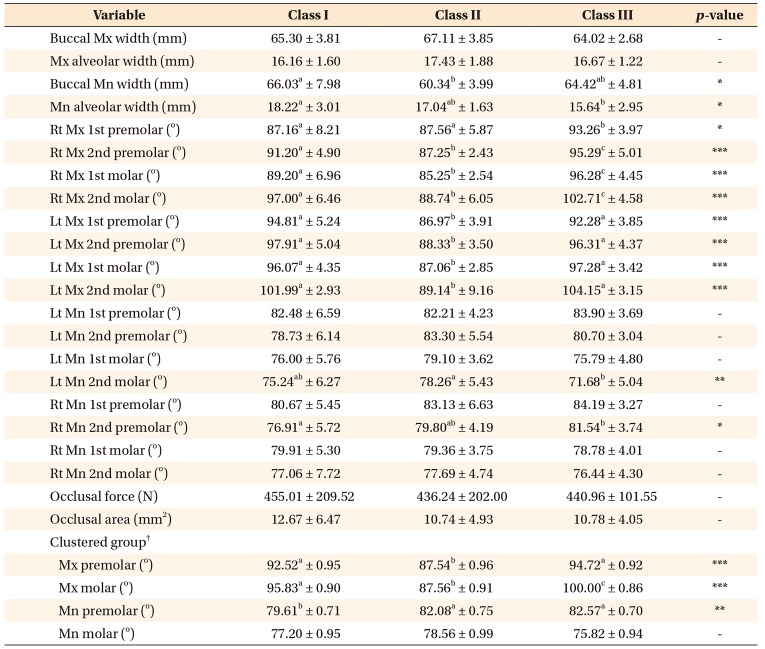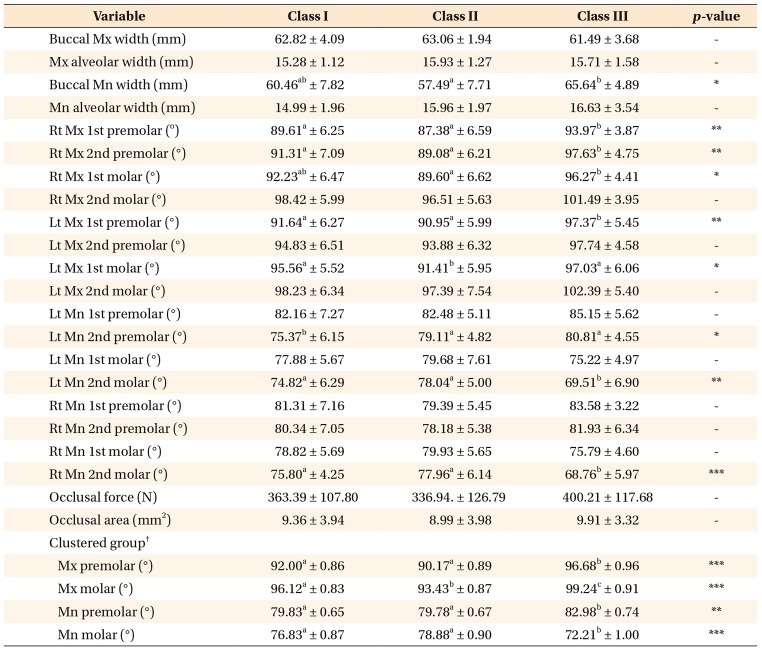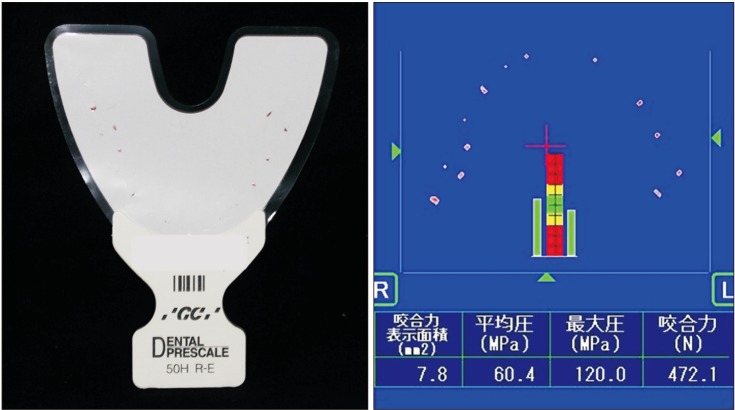1. Angle EH. Treatment of malocclusion of the teeth: angle's system. Philadelphia: White Dental Manufacturing Company;1907.
2. Hwang S, Song J, Lee J, Choi YJ, Chung CJ, Kim KH. Three-dimensional evaluation of dentofacial transverse widths in adults with different sagittal facial patterns. Am J Orthod Dentofacial Orthop. 2018; 154:365–374. PMID:
30173839.

3. Verma TP, Kumathalli KI, Jain V, Kumar R. Bite force recording devices - a review. J Clin Diagn Res. 2017; 11:ZE01–ZE05.

4. Choi YJ, Chung CJ, Kim KH. Changes in occlusal force and occlusal contact area after orthodontic treatment. Korean J Orthod. 2010; 40:176–183.

5. Sultana MH, Yamada K, Hanada K. Changes in occlusal force and occlusal contact area after active orthodontic treatment: a pilot study using pressure-sensitive sheets. J Oral Rehabil. 2002; 29:484–491. PMID:
12028498.

6. Suzuki T, Kumagai H, Watanabe T, Uchida T, Nagao M. Evaluation of complete denture occlusal contacts using pressure-sensitive sheets. Int J Prosthodont. 1997; 10:386–391. PMID:
9484050.
7. Okiyama S, Ikebe K, Nokubi T. Association between masticatory performance and maximal occlusal force in young men. J Oral Rehabil. 2003; 30:278–282. PMID:
12588500.

8. Proffit WR, Fields HW, Nixon WL. Occlusal forces in normal- and long-face adults. J Dent Res. 1983; 62:566–570. PMID:
6573373.

9. Riedel RA. The relation of maxillary structures to cranium in malocclusion and in normal occlusion. Angle Orthod. 1952; 22:142–145.
10. Ahn J, Kim SJ, Lee JY, Chung CJ, Kim KH. Transverse dental compensation in relation to sagittal and transverse skeletal discrepancies in skeletal Class III patients. Am J Orthod Dentofacial Orthop. 2017; 151:148–156. PMID:
28024769.
11. Kitafusa Y. Application of “prescale” as an aid to clinical diagnosis in orthodontics. Bull Tokyo Dent Coll. 2004; 45:99–108. PMID:
15536861.

12. Ross IF. Occlusal contacts of the natural teeth. J Prosthet Dent. 1974; 32:660–667. PMID:
4530104.

13. Braun S, Bantleon HP, Hnat WP, Freudenthaler JW, Marcotte MR, Johnson BE. A study of bite force, part 2: relationship to various cephalometric measurements. Angle Orthod. 1995; 65:373–377. PMID:
8526297.
14. Slaj M, Spalj S, Pavlin D, Illes D, Slaj M. Dental archforms in dentoalveolar Class I, II and III. Angle Orthod. 2010; 80:919–924. PMID:
20578864.

15. Lux CJ, Conradt C, Burden D, Komposch G. Dental arch widths and mandibular-maxillary base widths in Class II malocclusions between early mixed and permanent dentitions. Angle Orthod. 2003; 73:674–685. PMID:
14719732.
16. Baccetti T, Franchi L, McNamara JA Jr, Tollaro I. Early dentofacial features of Class II malocclusion: a longitudinal study from the deciduous through the mixed dentition. Am J Orthod Dentofacial Orthop. 1997; 111:502–509. PMID:
9155809.

17. Franchi L, Baccetti T. Transverse maxillary deficiency in Class II and Class III malocclusions: a cephalometric and morphometric study on postero-anterior films. Orthod Craniofac Res. 2005; 8:21–28. PMID:
15667642.

18. Wang YL, Cheng J, Chen YM, Yip KH, Smales RJ, Yin XM. Patterns and forces of occlusal contacts during lateral excursions recorded by the T-Scan II system in young Chinese adults with normal occlusions. J Oral Rehabil. 2011; 38:571–578. PMID:
21294761.

19. Owens S, Buschang PH, Throckmorton GS, Palmer L, English J. Masticatory performance and areas of occlusal contact and near contact in subjects with normal occlusion and malocclusion. Am J Orthod Dentofacial Orthop. 2002; 121:602–609. PMID:
12080313.

20. Lee H, Kim M, Chun YS. Comparison of occlusal contact areas of class I and class II molar relationships at finishing using three-dimensional digital models. Korean J Orthod. 2015; 45:113–120. PMID:
26023539.

21. Yoon W, Hwang S, Chung C, Kim KH. Changes in occlusal function after extraction of premolars: 2-year follow-up. Angle Orthod. 2017; 87:703–708. PMID:
28485615.

22. Ando K, Fuwa Y, Kurosawa M, Kondo T, Goto S. Bite force measurement system using pressure-sensitive sheet and silicone impression material. Dent Mater J. 2009; 28:212–218. PMID:
19496402.

23. Koc D, Dogan A, Bek B. Bite force and influential factors on bite force measurements: a literature review. Eur J Dent. 2010; 4:223–232. PMID:
20396457.

24. Maness WL, Podoloff R. Distribution of occlusal contacts in maximum intercuspation. J Prosthet Dent. 1989; 62:238–242. PMID:
2760866.

25. Bakke M. Bite force and occlusion. Semin Orthod. 2006; 12:120–126.

26. Roldán SI, Restrepo LG, Isaza JF, Vélez LG, Buschang PH. Are maximum bite forces of subjects 7 to 17 years of age related to malocclusion? Angle Orthod. 2016; 86:456–461. PMID:
26347948.

27. English JD, Buschang PH, Throckmorton GS. Does malocclusion affect masticatory performance? Angle Orthod. 2002; 72:21–27. PMID:
11843269.
28. Toro A, Buschang PH, Throckmorton G, Roldán S. Masticatory performance in children and adolescents with Class I and II malocclusions. Eur J Orthod. 2006; 28:112–119. PMID:
16272209.

29. Al-Nimri KS, Bataineh AB, Abo-Farha S. Functional occlusal patterns and their relationship to static occlusion. Angle Orthod. 2010; 80:65–71. PMID:
19852642.

30. Al-Hiyasat AS, Abu-Alhaija ES. The relationship between static and dynamic occlusion in 14-17-year-old school children. J Oral Rehabil. 2004; 31:628–633. PMID:
15210021.









 PDF
PDF ePub
ePub Citation
Citation Print
Print







 XML Download
XML Download